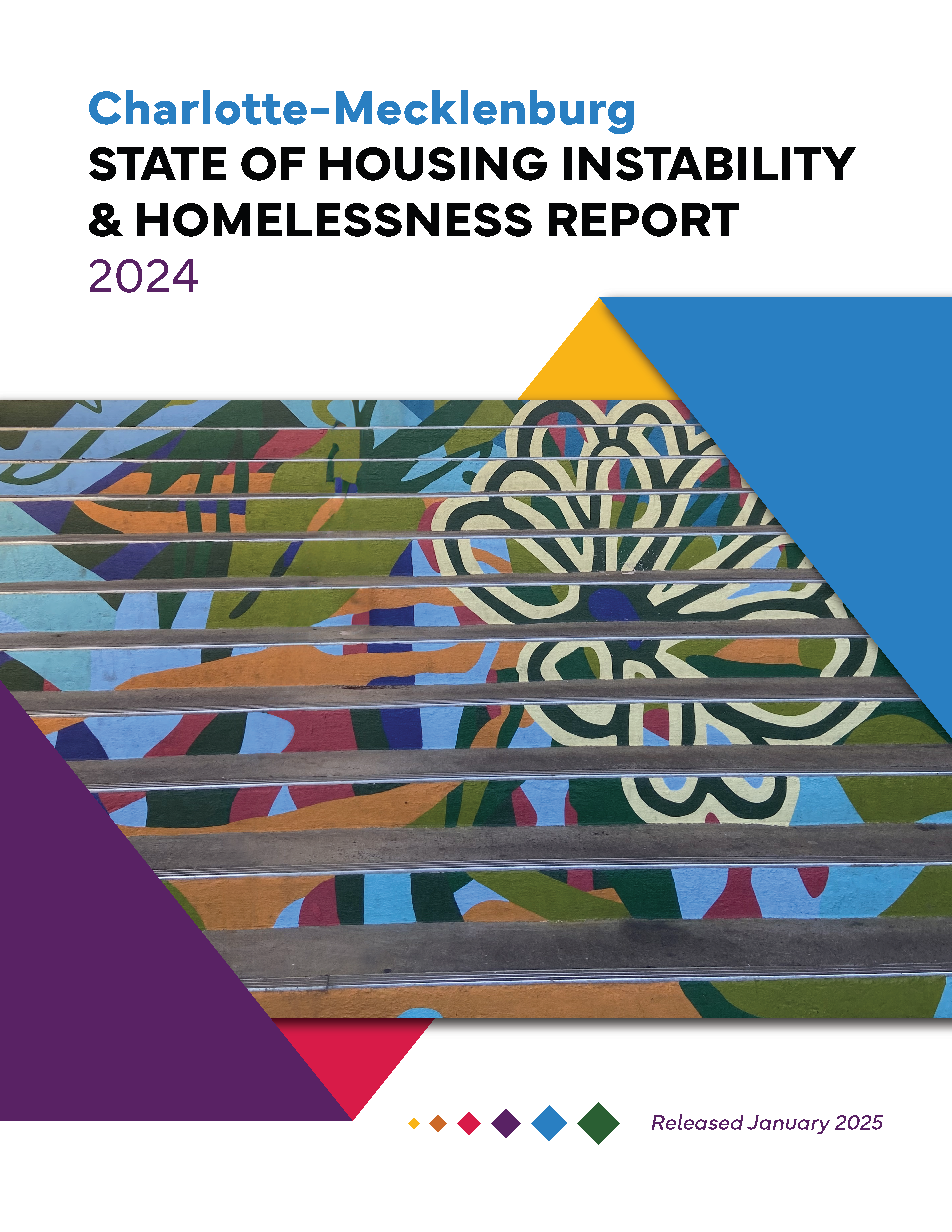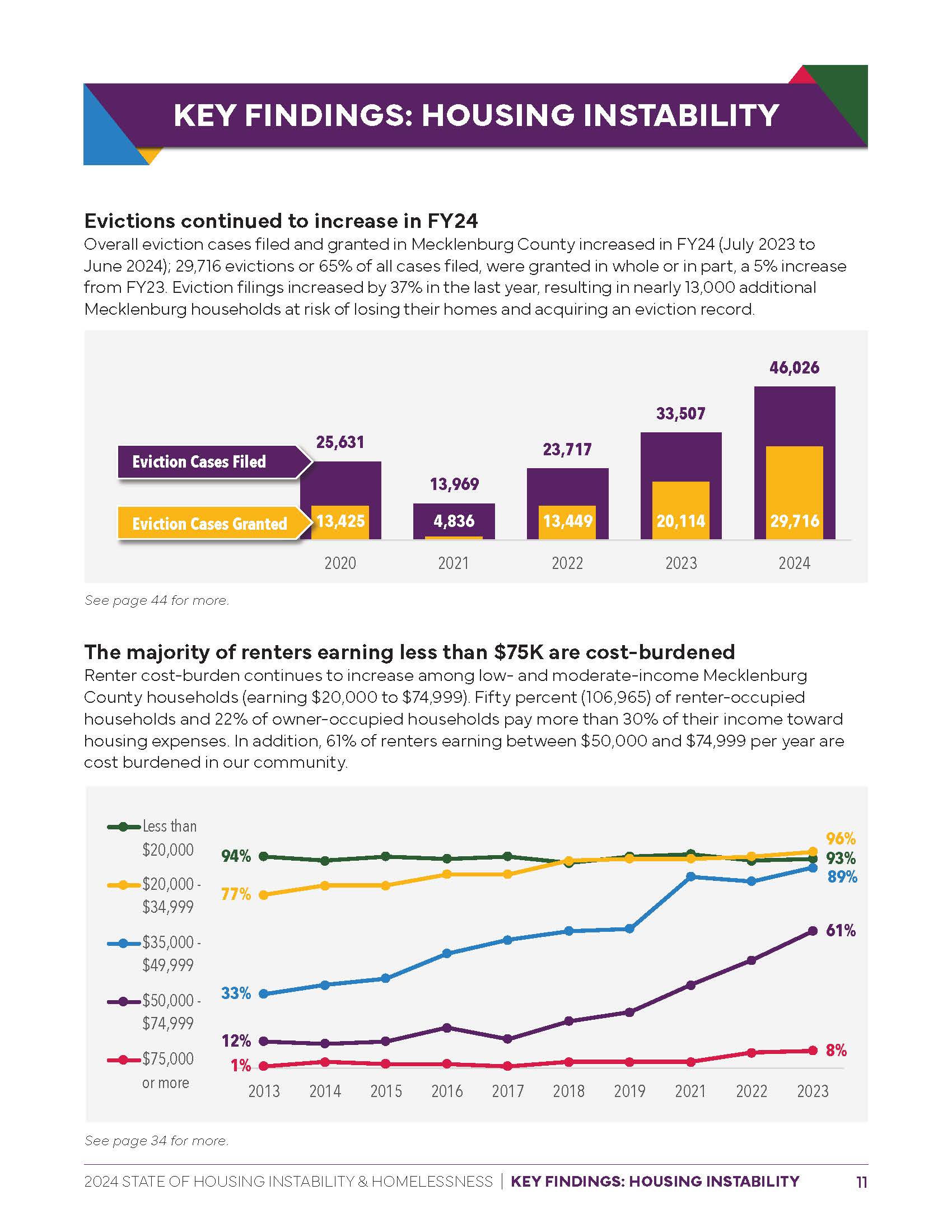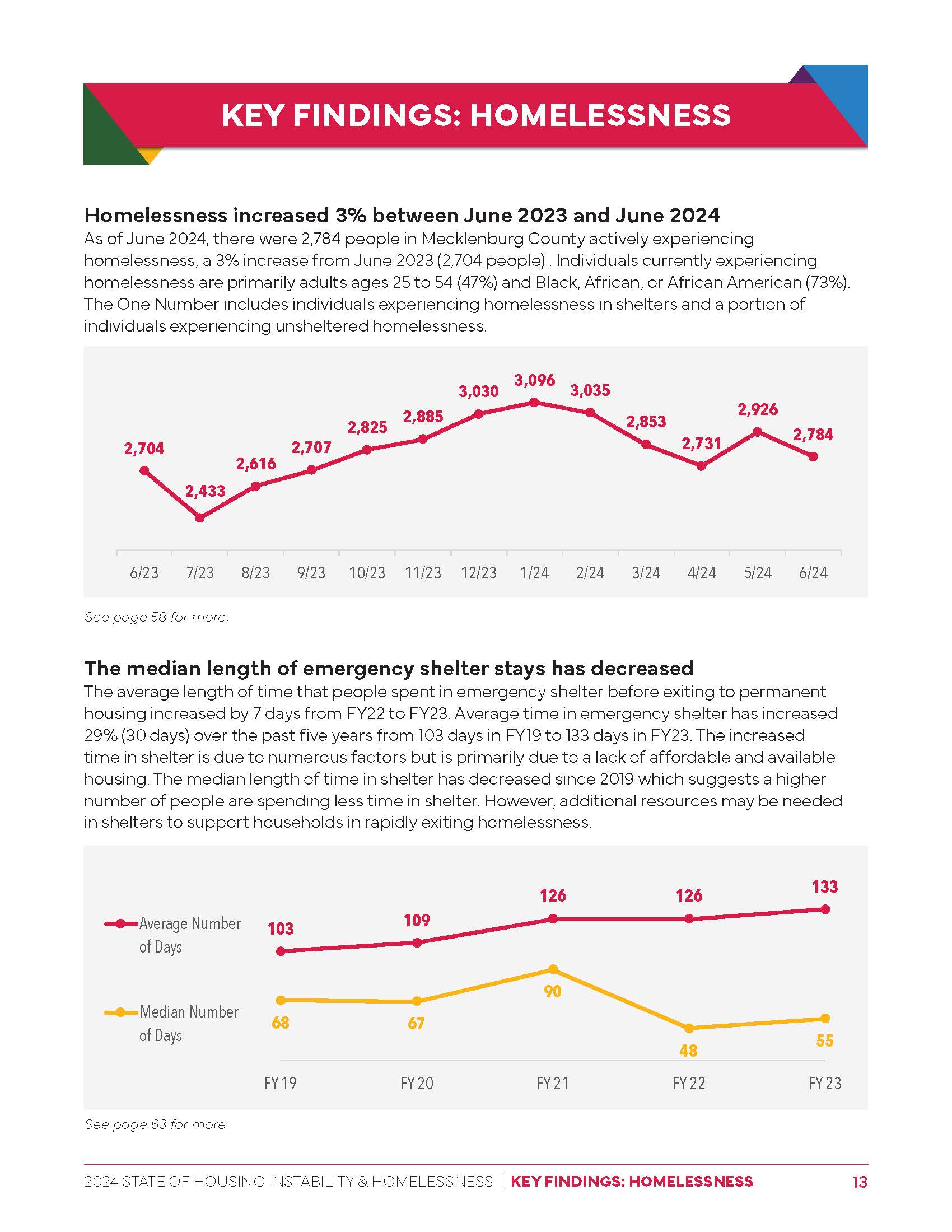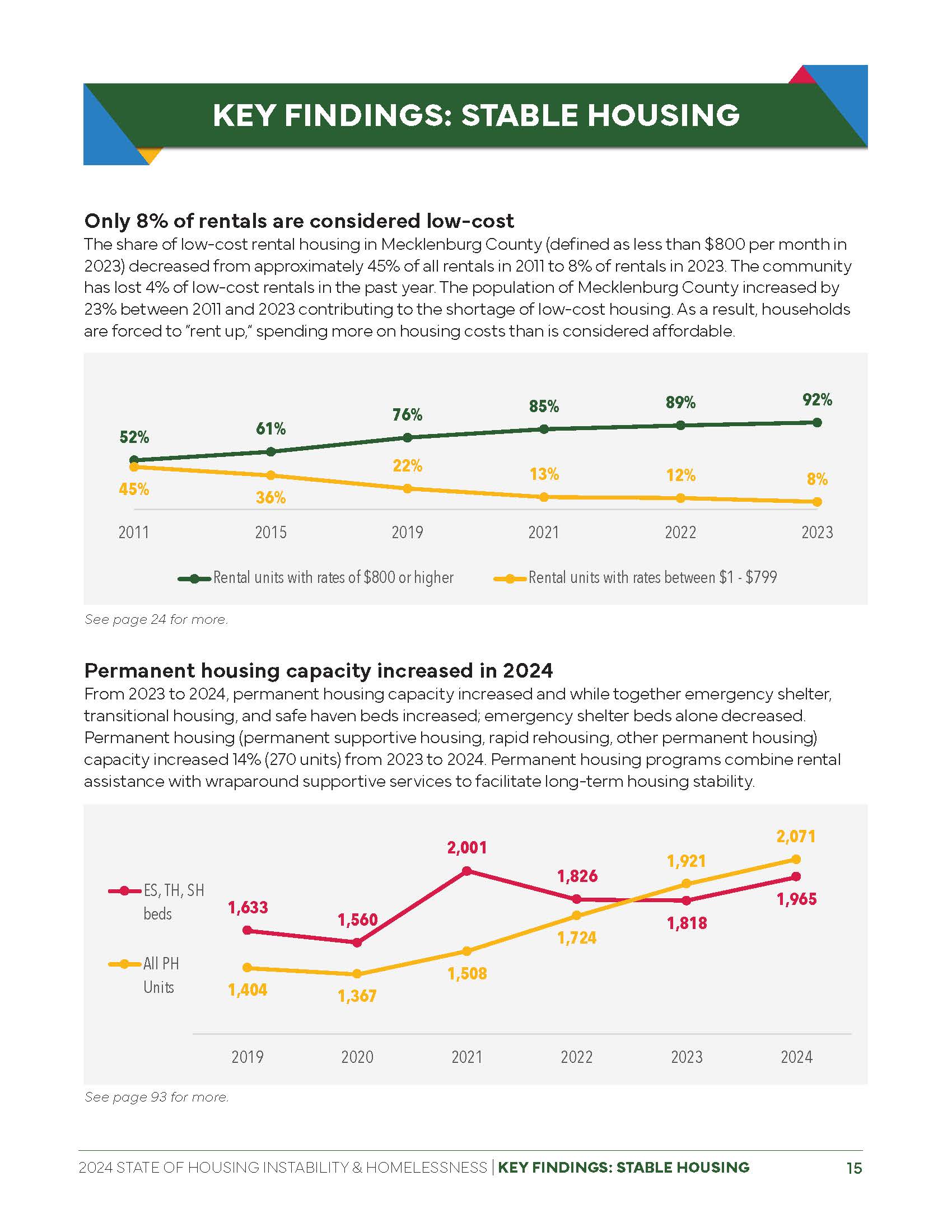Mary Ann Priester, PhD, MSW
Senior Management Analyst
Mecklenburg County Community Support Services
Housing Innovation & Stabilization Services Division
Today marks the release of the 2024 State of Housing Instability and Homelessness (SOHIH) report. This annual report, produced by Mecklenburg County Community Support Services, compiles the most recent data on housing instability and homelessness for Charlotte-Mecklenburg by synthesizing local, regional, and national data on the full housing continuum (from housing instability to homelessness to stable, permanent, affordable housing). The SOHIH report serves as a knowledge base for all stakeholders to inform policy and practice decisions, optimize resource allocation, plan integrated systems of care, and drive advocacy efforts.
This blog post outlines the key findings from the 2024 SoHIH and what these findings could mean for Mecklenburg County.
KEY FINDINGS
The 2024 SoHIH report updates standard community metrics related to housing and homelessness, covering aspects such as cost-burden, evictions, Point-in-Time Count, housing inventory, rental gaps, Housing Trust Fund, and system performance metrics. New data this year includes information on substandard housing and survey data from the first ever Detention Center Point-in-Time Count. In addition to updated data, this year’s report also includes expanded information on local efforts, governmental financial investments in housing and homelessness, and emergent promising practices related to housing instability, homelessness, and stable housing.
WHAT WE KNOW
- Low-cost rentals are disappearing. Low-cost housing for low-income households now accounts for 8% of the total housing stock, down from 45% in 2011. There is a 27,693-unit gap in rental units affordable for extremely low-income households who are at or below 30% of Area Median Income in Charlotte-Mecklenburg.
- Low- and moderate-income households are struggling to afford rent and keep their housing. A lack of affordable housing and a growing rent-to-income gap contribute to the number of rental households in Mecklenburg County who are housing cost burdened. Sixty-one percent of renters earning less than $75K per year are cost burdened.
- Evictions continue to increase. Sixty-five percent of eviction cases filed in FY24 were granted in full or part, a 5% increase from FY23. Eviction filings increased 37% in the past year, resulting in an additional 13,000 Mecklenburg households at-risk of losing their homes and/or acquiring an eviction record.
- The number of people experiencing homelessness in Charlotte-Mecklenburg continues to increase. As of June 2024, there were 2,784 people in Mecklenburg County actively experiencing homelessness, a 3% increase (from 2,704 people) from June 2023.
- The number of people experiencing unsheltered homelessness has increased. According to 2024 Point-in-Time (PIT)count data, there were 384 people experiencing unsheltered homelessness in Mecklenburg County; a 33% increase since the 2023 PIT (288 people).
- The average length of time people stay in emergency shelter has increased while the median length of time has decreased. The average length of time that people spent in emergency shelter and safe haven increased by 7 days from FY22 to FY23. The median length of time in emergency shelter and safe haven increased by 7 days from FY22 to
- FY23 but the median number of days in shelter has decreased 19% between FY19 and FY23.This suggests the system can facilitate rapid exit from homelessness but still has some long-term shelter stayers.
FOR MORE INFORMATION
The annual State of Housing Instability & Homelessness (SoHIH) Report provides a comprehensive compilation of the most recent data on housing instability and homelessness in Charlotte-Mecklenburg. It illustrates the critical role of data in addressing needs across the full housing continuum from housing instability to homelessness to safe, permanent, affordable housing. The report is structured into four primary sections: homelessness (both sheltered and unsheltered), housing instability, (e.g., doubled up, housing cost-burdened), stably housed (permanent and affordable housing), and connecting the dots (local efforts, investments, and emergent needs). It presents data on both the demand side of the housing continuum, from housing instability to homelessness, and the supply side, which includes all types of permanent, affordable housing.
The SoHIH report also includes data that highlights systemic and structural factors influencing racially disproportionate experiences of housing instability and homelessness, provides insights into the demand for housing-related resources and services in Charlotte-Mecklenburg, assesses the local system’s capacity to meet emerging needs, and evaluates effectiveness of the housing continuum in meeting the needs of the residents of Mecklenburg County.
WHY DOES THIS MATTER
To effectively address homelessness and housing instability in Charlotte-Mecklenburg, a data and equity-driven, coordinated, and multifaceted approach is necessary. This approach should integrate affordable housing strategies, robust and flexible financial assistance, and dedicated funding to expand support services in all areas of the homelessness response system from prevention to shelter services to housing. Strategic alignment, shared responsibility, and targeted resources and interventions that strengthen local housing continuum resource capacity and reduce systemic barriers to housing are essential as the community continues its work to ensure that homelessness is rare, brief, and non-recurring and that all households in Mecklenburg County have access to safe, decent, and affordable housing.
The 2024 SoHIH report and all complementary material can be found on the Charlotte-Mecklenburg Housing & Homelessness Dashboard.
HOW TO HELP
Residents can help in several ways, especially before and during the annual Point in Time Count.
- Spread the Word: Use your voice to raise awareness and share the information in the report with friends, family, and networks via social media. Use this report to inform corporations, business owners, funders, and employers in how they can be part of the solution by supporting and partnering in the local work to prevent and end homelessness. Use this report to engage local and state policy makers about affordable housing by:
- Attending Board of County Commissioners and City Council meetings or review the meeting minutes to ensure you are aware of the actions local government is taking to address affordable housing challenges locally.
- Finding opportunities to speak and provide input by attending town halls, public hearings, or community meeting.
- Following elected officials on social media and set up a time to meet with officials or their staff to discuss your concerns and potential solutions.
- Advocating for more housing resources at the state and federal levels.
- Support the 2025 Point-in-Time Count: On January 23, 2025, we need support to help people experiencing homelessness. Check out the Amazon Wishlist to donate essential items for people sleeping outside in our community. Make a financial contribution to provide these supplies and a warm breakfast for our neighbors on the morning of the Point-in-Time Count. To make a financial contribution to Hearts for Invisible Coalition, the lead outreach organization in our community, click here.
- Stay Connected Year-round: Get and stay plugged in to the year-round work to prevent and end homelessness in Mecklenburg County by signing up to receive the Building Bridges Blog and Continuum of Care Weekly Digest. Sign up here.
SIGN UP FOR BUILDING BRIDGES BLOG
Mary Ann Priester is a Senior Management Analyst for Mecklenburg County Community Support Services on the Housing, Innovation, and Stabilization Services team. In this role, she serves as the Housing and Homelessness Data and Research Coordinator for Mecklenburg County. Her role is to connect community stakeholders with actionable data and research to inform decision-making around policy, funding, and programs addressing housing instability and homelessness.





